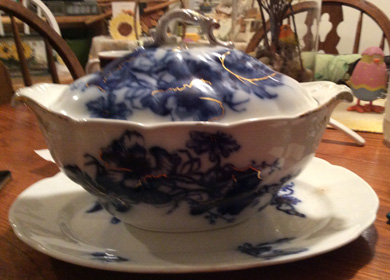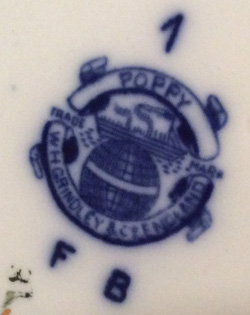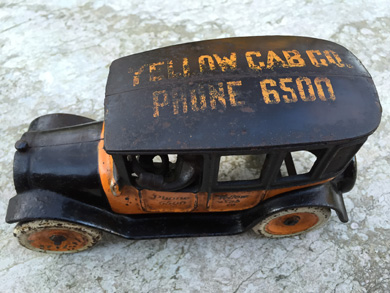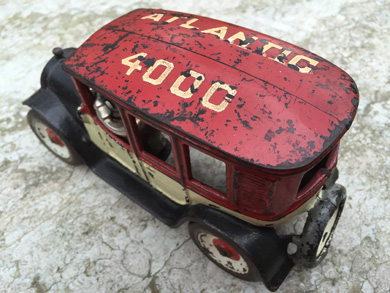 |
|
|||
 |
 |
|||
Copyright © Harry Rinker, LLC 2016 Questions
and Answers
QUESTION: I own a W. H. Grindley, Poppy pattern, covered soup tureen and under platter. I believe these pieces are over 50 years old. What exactly do I have and what is its value? – SS, Reading, PA, Email Question
ANSWER: William Harry Grindley (1859-1926) and Alfred Meakin founded W. H. Grindley in Tunstall, Stoke-on-Trent, in 1880. The company used the former Newfield Pottery to make its glazed earthenware. Many examples were marketed as ironstone china. [Author’s Aside #1: Ironstone did not contain iron. It received this designation because of its durability and strength.] The Grindley-Meakin partnership dissolved in 1884. In 1891, W. H. Grindley moved to the Woodland Pottery. In 1960, Alfred Clough acquired W. H. Grindley. A number of ownership changes ensued. Woodlands Pottery acquired the company when it went into receivership in 1991. The backstamp on your platter was used by W. H. Rival Staffordshire potteries often created patterns that were similar to successful patterns of their competitors. Samuel Alcock in Burslem, Johnson Brothers in Hanley, Stoke-on-Trent, and Wedgwood in Burslem, issued decorative accessories and dinnerware in a blue “poppy” pattern. When seeking to identify an English ceramic mark in the past, I turned to Geoffrey A. Godden’s “Encyclopedia of British Pottery and Porcelain Marks,” (copyright by the author, 1964; reprinted by Schiffer Publishing), a mark reference book that has been on my shelf since I first started researching and writing about antiques and collectibles. Since I now live in the digital age, I decided to see what information was available on the internet to learn more about the backstamp. The website www.thepotteries.org contains a detailed list of backstamps and marks used by the Staffordshire potters in Stoke-on-Trent, England. I found the backstamp immediately on the W. H. Grindley marks URL. As a member of WorthPoint.com’s MAPS (marks, autographs, patterns, and symbols) program, I did a quick search using “globe +banner +Grindley.” Clicking on “MARKS,” I found additional information, confirmation of the production of ironstone and that the backstamp appeared with a variety of pattern names. Remaining on WorthPoint.com, I did a search for “W. H. Grindley +Poppy.” Over 25 pieces appeared providing a wide range of comparable prices. There was a listing for a four-piece sauce tureen (cover, body, under plate) and ladle in the Poppy pattern. It sold for $325.00 on August 20, 2010 on eBay. The sauce tureen closely resembles the soup tureen in shape. Since there was no ruler in your image nor size in the information you sent, I am concerned you may not have correctly identified the form. In addition, you did not provide a view of the lid. If there is a “U” opening, chances are you are missing the ladle and the set is incomplete. If there is no opening for a ladle, then you may have a covered vegetable. Covered vegetables do not have under plates. A harlequin set could be created by putting a smaller platter under the covered vegetable. A critical point is what happened to the values within the flow blue ceramics secondary market since 2010. The answer is a major decline in market value, especially for commonly found forms. In the good news category, soup tureens are usually the highest price form in any ceramic pattern. In the not so good news, Poppy, a later flow blue pattern, is not among the most desirable flow blue designs. In the 2016 secondary market, a W. H. Grindley Poppy pattern soup tureen has a value of between $275.00 and $325.00. Deduct $50.00 if the ladle is missing. QUESTION: I have two cast iron Arcade taxi cab toys. The roof of one reads: “YELLOW CAB CO. / PHONE 6500” and the roof of the second “ATLANTIC / 4000.” They are in fair condition, showing paint fading and loss, pitting, and rust. Besides wanting to know their value, I would like to identify the location of the telephone numbers. Can you help? – JG, Southeast PA, Email Question. ANSWER: JG, who lives in southeast Pennsylvania, listens to WHATCHA GOT?, my syndicated antiques and collectibles call-in radio show, on Tunein Radio streaming from KNPT (Newport, Oregon). Welcome to the digital age. When I first saw the images and the aging, I was concerned that these might be reproductions (exact copies) or copycats (stylistic copies) of period pieces. Ed Sanford’s article “Arcade Taxi Review – A Savannah, GA Find” on www.antiquetoys.com [http://www.antiquetoys.com/arcade-taxi-review-a-savannah-ga-find/] provided information about an identical Arcade Yellow Taxi #2, which he authenticated as period due in part to the driver having a dark silver appearance, a hat with an orange stripe on the top, and a square nut holding the driver in place
Sanford has more expertise than I do in respect to cast iron toys. Logic suggests I should accept his conclusions and move on. However, I have a questioning mind. In comparing the text on the roof of Sanford’s find to your example, the loss and wear pattern is virtually identical. Seeing this set off my mental alarm bells. What is the possibility that two examples with identical wear would appear on the market? The only safe answer is that you acquired the Sanford example. If this is not the case, there is a problem. Sanford discovered that the “6500” phone number belonged to the Seattle, Washington, Yellow Cab Company, thus making it a custom printing order. The same would apply to your “ATLANTIC 4000” taxi, albeit I was not able to identify the location of the number.
The paint color scheme on the “ATLANTIC 4000” taxi, red top, white body, and black carriage and hood does correspond to Arcade’s Red Top taxi paint scheme. I did locate another example of an Arcade taxi with “ATLANTIC 4000” on the internet. As part of my research, I talked to and emailed Dave Bausch, one of the foremost automobilia/toy vehicle collectors in America. Dave noted the wear of the text was identical to those in his collection. He felt the text may have been added after the taxis left the factory, which explains why it is not a fired on paint. There are times in the antiques and collectibles field where your head and heart are in conflict. My heart wants your examples to be period Arcade taxis. My head keeps telling me to think twice, three times, and even more. There are too many “whys.” Why is the wear on the tops of all “PHONE 6500” roofs identical? What are the circumstances that led to a custom painted toy for a Seattle cab company be found outside the Seattle area? When teaching authenticating, one rule is: when in doubt, keep questioning until all the answers satisfy you. The answers satisfied Ed Sanford and Dave Bausch. They have not satisfied me. More research is needed. Until I know what you have, I cannot determine its value. This research hunt continues. QUESTION: I have a six-page flyer from the Samuel Clemens House in Hartford, CT. The flyer is signed in ink “Yours truly. Samuel, Clemens mark twain.” My great grandfather to whom the flyer belonged and Twain knew each other. I would like to sell this but do not know how to go about it. Thank you for any help you can offer. – SM, Coca, FL, E-mail Question ANSWER: I am not certain what you have, albeit you seem certain. Samuel Clemens (Mark Twain) lived in his home in Hartford from 1874 to 1891. Although subject to frequent visitors while living in Hartford, it is hard to accept that Clemens had a printed six-page flyer about his house available for signing when guests appeared. The Clemens family moved to Europe in 1891. Clements spent 1895-1896 traveling and lecturing to pay his debts. While on the road, the Clemens’ daughter, Suzy, died in August 1896. The family did not reside in the home afterwards. In 1903, Clements sold the house. Clemens died on April 21, 1910. Facing demolition in 1929, the Mark Twain Memorial, a non-profit group, purchased the home. My guess is that your six-page flyer dates from the post-1929 period and that Clemens’ signature is printed as part of the document. If I am correct, your flyer has more curiosity than dollar value. I hate “why if it were ____” questions. You provided no images of the flyer and signature. As such, I cannot assume the signature is period. I did speak to Steve Courtney (steve.courtney@marktwainhouse.org) to see if he knew of any period six-page flyer distributed by Clemens. He did not. Steve told me that Clemens lived in Redding, Connecticut, in “Stormfield,” a house Clemens had built, from June 1908 until his death. While a resident of Redding, Clemens sold tickets to raise funds to support the Mark Twain Library in Redding. Again, Steve has no knowledge of a flyer issued for Stormfield or the library during Clemens’ lifetime. Harry L. Rinker welcomes questions from readers about
collectibles, those mass-produced items from the twentieth and twenty-first centuries.
Selected letters will be answered in this column.
Harry cannot provide personal answers.
Photos and other material submitted cannot be
returned.
Send your questions to: Rinker on Collectibles, 5955 Mill
Point Court SE, Kentwood, MI 49512.
You also can e-mail your questions to
harrylrinker@aol.com.
Only e-mails containing a full name and mailing address
will be considered.
You can listen
and participate in
WHATCHA GOT?, Harry’s
antiques and collectibles radio call-in show, on Sunday mornings between 8:00 AM
and 10:00 AM Eastern Time.
If you
cannot find it on a station in your area,
WHATCHA GOT?
streams live on the Internet at www.gcnlive.com.
SELL, KEEP OR TOSS?: HOW TO DOWNSIZE A HOME,
SETTLE AN ESTATE, AND APPRAISE PERSONAL PROPERTY
(House of Collectibles, an imprint of Random House Information Group, $17.99),
Harry’s latest book, is available at your favorite bookstore and via
www.harryrinker.com.
|
||||

 Grindley, a north Staffordshire pottery, beginning around 1892 and extending to 1914. Prior to 1891, Grindley used a similar backstamp that used “TUNSTALL” rather than “ENGLAND” as the location identifier. The change to “ENGLAND” was a response to a provision in the 1890 McKinley Tariff Act requiring goods imported into the United States be marked with their “country” of origin. The “F B” below the logo indicates that Poppy is a “Flow Blue” pattern.
Grindley, a north Staffordshire pottery, beginning around 1892 and extending to 1914. Prior to 1891, Grindley used a similar backstamp that used “TUNSTALL” rather than “ENGLAND” as the location identifier. The change to “ENGLAND” was a response to a provision in the 1890 McKinley Tariff Act requiring goods imported into the United States be marked with their “country” of origin. The “F B” below the logo indicates that Poppy is a “Flow Blue” pattern.
